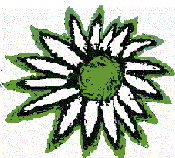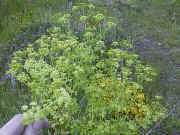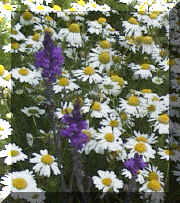|
Design
By Nature - wildflowers.ie - Irish Wildflowers 
|
|
Species Datapage No 1
|
|
You may
click on most photographs to enlarge. *Denotes a Naturalised
species
|
|
Scroll down to find a species
|
|
Return to Species
List Index Page
|
|
|
| Species Common Name:
Alexanders*
|
| Species Botanical Name:
Smyrnium olusatrum
|
|
|
|
A tall introduced
biennial pot herb, introduced by the Romans. Alexanders will
spread and establish after the a few years.
We use it to suppress
weeds at the edge of woodland and hedgerow.
It attracts insects in early
spring when few other species are flowering
|
 In
a mild year, it flowers for St. Patrick's Day, and can be incorrectly
called St. Patrick's Cabbage. This useful shade
tolerant herb likes frost free seaside conditions but it does grow in
the midlands of Ireland and puts up with lots of frost, having survived
many years in parts of Co. Laois. In
a mild year, it flowers for St. Patrick's Day, and can be incorrectly
called St. Patrick's Cabbage. This useful shade
tolerant herb likes frost free seaside conditions but it does grow in
the midlands of Ireland and puts up with lots of frost, having survived
many years in parts of Co. Laois.
|
| I very much
like this herb and it should be used more especially with young trees as
it suppress grasses, which as I keep saying kill trees.
|
| Management:
Biennial, persistence in shady places: if
unwanted - control seed heads and seedlings, cannot spread if
self-seeding is controlled for two years
|
|
Tolerance of cutting: medium, will re-grow
and flower short if cut in spring.
|
|
Cutting time: Summer
|
|
|
|
Edible / Medicinal: pot herb (celery like), dried flower/seed heads for decorations
|
|
|
|
Life Cycle (Form):
Biennial
Flower Height:
90 to 200 cm
Foliage Height:
40 - 80 cm
Flower Colour:
Lime green.
Flowering period:
March - May, depending.
Time to Flower:
12 months
Soil Type:
Most, best in deep dry, light and rich soil. Waste Places
pH Type: Neutral
Moisture:
Dry
Aspect:
Shade to full sun, frost free
Wildlife Value: low
|
|
|
|
Return to Species
List Index Page
|
|
|
| Species Common Name: Annual
Mayweed*
|
|
Species Botanical Name:
Matricaria perforata.
Also named (Tripleuspermum spp) (Chamomilla suaveolens) (Matricaria
chamomilla) Some confusion exists over the naming and identification of
this genus and species. We have at least four distinct types in our
genebank and crops and one (Anthemis cotula 'white flowering') is reported as nearly extinct in Web's flora.
Search our species data pages for Sea Mayweed, Pineapple Mayweed,
Wild
Chamomile or Corn Chamomile, all are
similar.
|
|
|
 Photograph shows Purple
Toadflax among Annual Mayweed Photograph shows Purple
Toadflax among Annual Mayweed
|
|
|
|
Good for flower arranging, sample for scented varieties. Excellent
at attracting wildlife especially Finches. May wild meadow
mixtures contain Mayweed. This plant is vital on difficult soils
and as a nurse crop. On certain soils it will become dominant but
only for the first year. if out growing other species cut the meadow
hard back.
|
| Management:
Annual, control seeding if unwanted.
|
|
Tolerance of cutting: medium, will re-grow
and flower short if cut in spring / summer. will re-grow and flower in
grass in first year.
|
| Cutting
time: Summer
|
|
Edible / Medicinal: pot herb (celery like), dried flower/seed heads for decorations
|
|
|
|
Life Cycle
(Form): Annual
Flower Height:
30 - 80 cm
Foliage Height:
10 - 30
Flower Colour:
White with yellow centre
Flowering period:
July to November
Time to Flower:
16 weeks
Soil Type:
All
pH Type:
Neutral to Alkaline
Moisture:
Any, except flooded
Aspect:
any except deep shade
Wildlife
Value: Good
Note: An excellent
pioneer and nurse crop that can flower in second year from self seeding
|
|
Return to Species
List Index Page
|
 In
a mild year, it flowers for St. Patrick's Day, and can be incorrectly
called St. Patrick's Cabbage. This useful shade
tolerant herb likes frost free seaside conditions but it does grow in
the midlands of Ireland and puts up with lots of frost, having survived
many years in parts of Co. Laois.
In
a mild year, it flowers for St. Patrick's Day, and can be incorrectly
called St. Patrick's Cabbage. This useful shade
tolerant herb likes frost free seaside conditions but it does grow in
the midlands of Ireland and puts up with lots of frost, having survived
many years in parts of Co. Laois.
 Photograph shows Purple
Toadflax among Annual Mayweed
Photograph shows Purple
Toadflax among Annual Mayweed